recycling
At ‘Garbage Cafes,’ You Can Trade Plastic Bottles for Free Food
Every morning, Akash, a 28-year-old living in Delhi, ventures out to collect plastic in order to feed his family of four.
He usually starts his day by scavenging for plastic bottles in and around the waste collection areas of different neighborhoods. He begins around 7am, when the waste from nearby houses typically arrives. His aim: to gather around three kilograms of plastic, which is enough to secure his meals for the day.
Each item he collects feels like a small victory, he says, adding up to a “bag of treasures” that he can exchange for food at what’s known as a “garbage cafe.” All three meals of the day, not only for him but for his whole family, are taken care of by these cafes across the city.
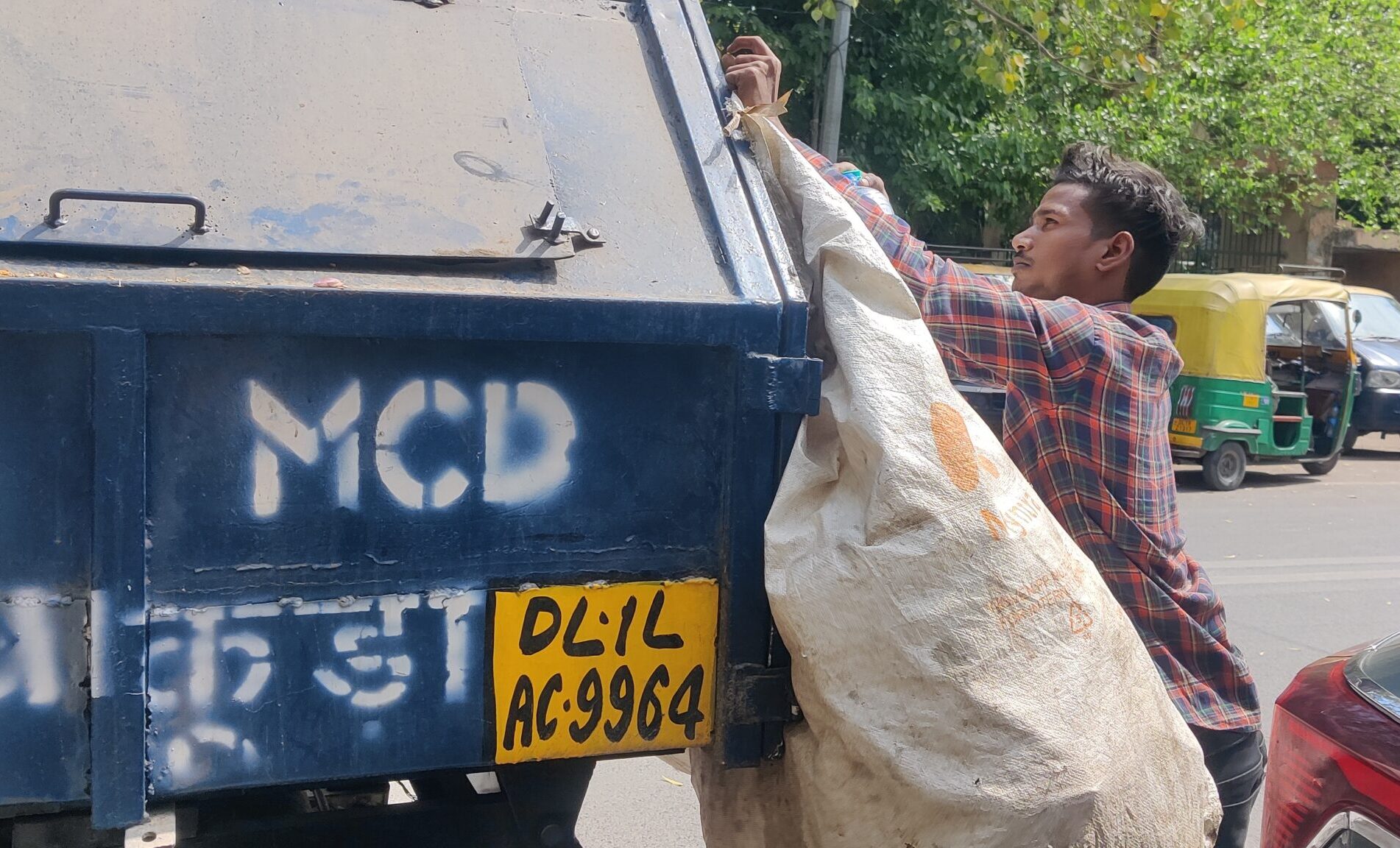 Akash often spends his day looking out for plastic bottles in the city. Credit: Rishabh Jain
Akash often spends his day looking out for plastic bottles in the city. Credit: Rishabh Jain
In a bid to preserve the environment and increase awareness about safe disposal of plastic waste, the Municipal Corporation of Delhi (MCD) came up with the concept of garbage cafes in 2020. Under this initiative, individuals who drop off one kilogram of plastic waste at designated garbage cafes receive a voucher for a complimentary meal at participating restaurants. (One kilogram can be exchanged for lunch or dinner, while just 250 grams can be exchanged for breakfast.) Eligible plastic waste includes empty water bottles, soft drink bottles, plastic containers and similar materials.
The aim is to encourage the gathering of waste while also managing the use of disposable plastic products. Eateries hand over the plastic they collect to a municipal organization, which then recycles and repurposes it.
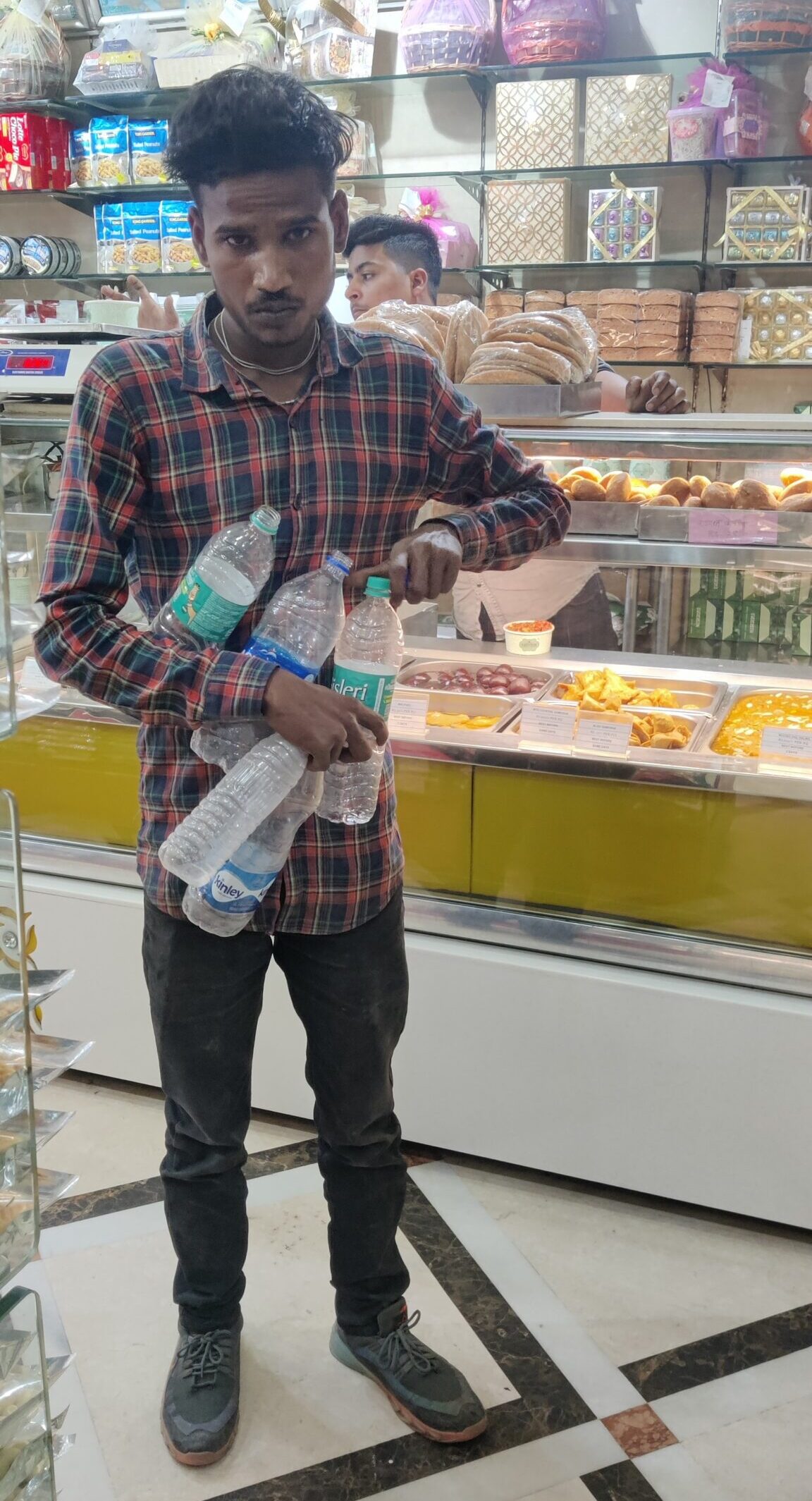 “This has really made my life easier,” says Akash. Credit: Rishabh Jain
“This has really made my life easier,” says Akash. Credit: Rishabh Jain
For Akash and many others, the cafes have been life-changing. “I came to Delhi around three years ago and started living with my relatives here,” Akash says. “While looking for a job I came across this scheme of the government where we can exchange plastic for free meals. This has really made my life easier, as I not only earn money out of selling plastic but also get free meals for my entire family.”
Business owners have seen benefits too, both environmentally and economically. Yash Kumar owns Evergreen Cafe in South Delhi. In the short time since his business was designated a garbage cafe, he says he has already seen the way the initiative has made people aware of the importance of safely disposing of plastic waste so that it gets recycled and reused, rather than ending up in landfills.
“I have seen an active participation by the people,” says Kumar, who notes that about 20 people have come to the cafe to ask about the program. “The authorities have also installed a plastic crusher machine right outside where the plastic gets safely [broken down]. We not only provide food and refreshments to people but also educate them about recycling plastic waste.”
Pointing at a pile of garbage just outside the shopping complex, predominantly consisting of plastic waste, Yash expresses that his decision to participate in this program was primarily driven by the desire to contribute positively to the city, though he also appreciates that it provides publicity for his cafe.
Mahesh, who works at Evergreen Cafe, adds that the MCD has also put up a banner outside their shop in order to spread awareness.
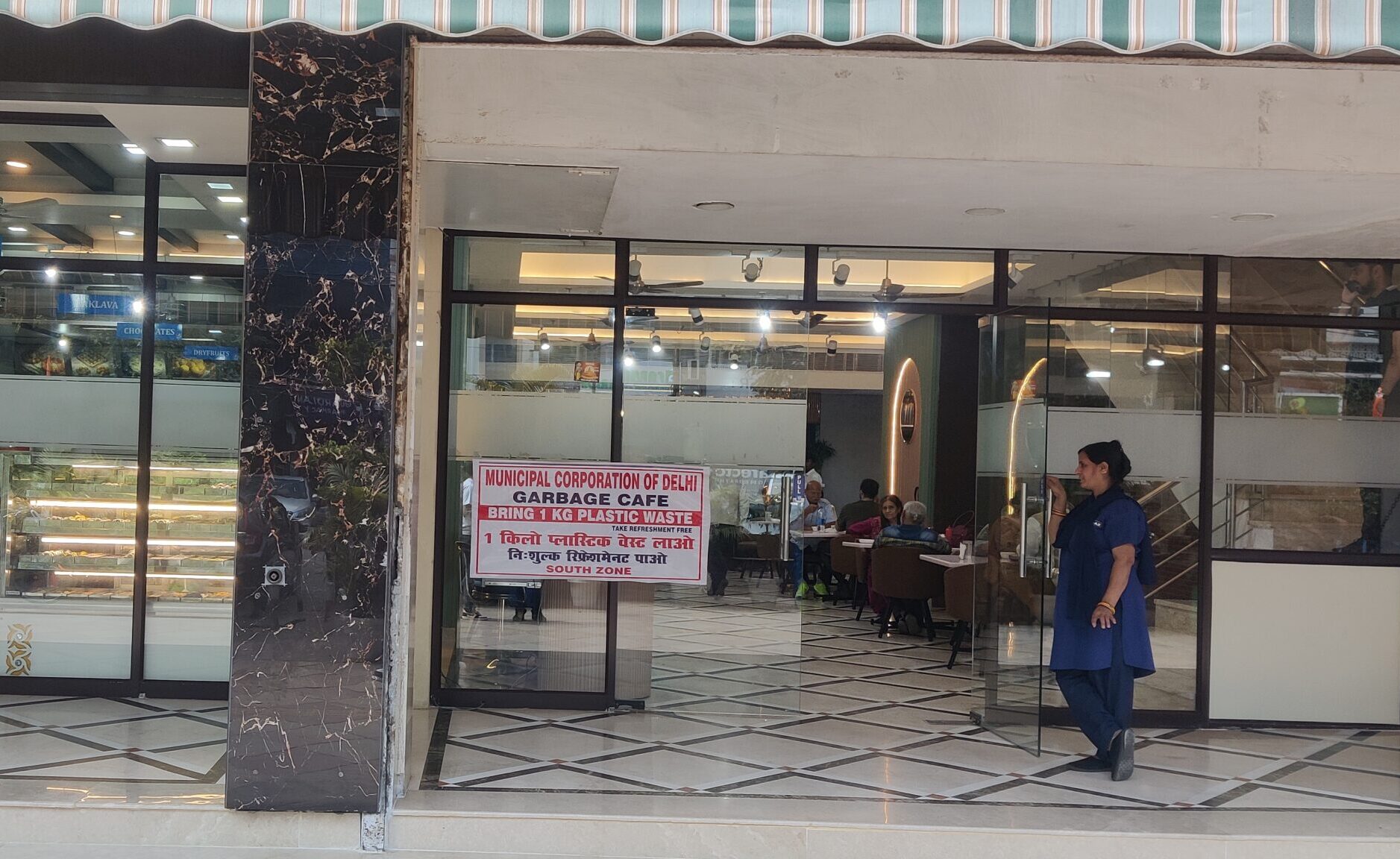 The Municipal Corporation of Delhi came up with the concept of garbage cafes in 2020. Credit: Rishabh Jain
The Municipal Corporation of Delhi came up with the concept of garbage cafes in 2020. Credit: Rishabh Jain
“People observe the banner, inquire about the process, and then come back with plastic bottles,” he says. “A significant number of them are motivated not by discounts but by the desire to make a contribution, which further motivates us. With increased publicity, we are confident that more individuals will join our cause.”
Tackling plastic pollution in Delhi
The capital city houses a population of 20 million and generates approximately 11,000 metric tons of municipal solid waste daily, the highest among Indian cities. According to government data, more than half of this waste is deposited in landfills.
Roughly 70 percent of the city’s plastic waste consists of single-use items, the majority of which either accumulate in landfills or obstruct drainage systems. This poses a significant threat to hungry cows, as they often scavenge through garbage bins, consuming plastic inadvertently.
Additionally, treatment capacity has not kept up with the volume of sewage the city produces, a trend observed not only in Delhi but also across the country. Experts suggest that raising awareness about waste sorting and expanding treatment capacity could be instrumental in addressing these challenges.
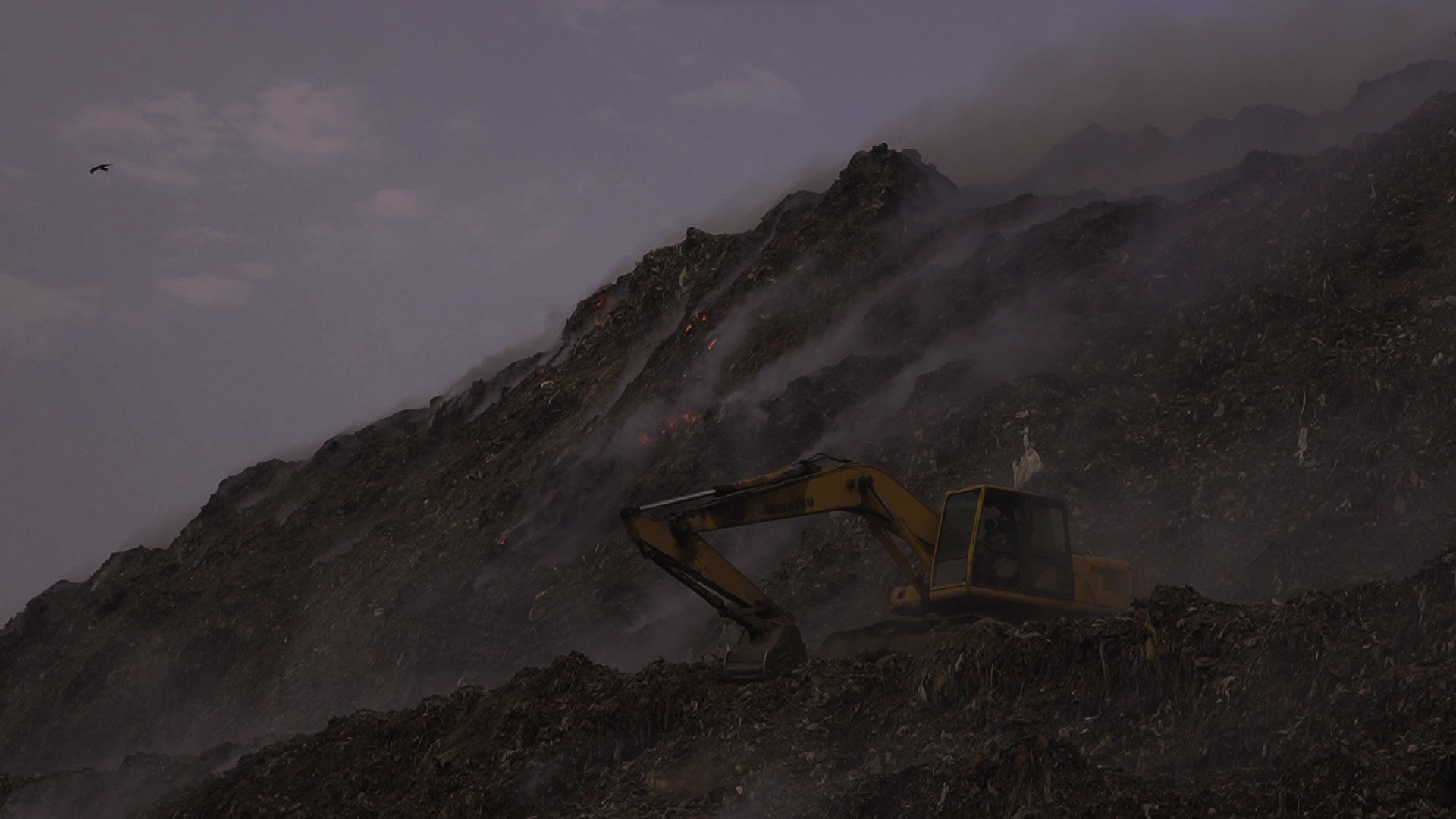 A landfill site in Delhi, where garbage often ends up burning and polluting the environment. Credit: Rishabh Jain
A landfill site in Delhi, where garbage often ends up burning and polluting the environment. Credit: Rishabh Jain
In another attempt to address the city’s plastic waste problem, the Delhi Pollution Control Committee introduced a prohibition on plastic bags smaller than 50 microns in 2015. Heavy fines have made the ban’s enforcement effective.
Efforts to reduce single-use plastic received a significant endorsement in 2019, when India’s Prime Minister Narendra Modi used the occasion of the 150th anniversary of Mahatma Gandhi’s birth to declare India’s commitment to phasing them out, though he fell short of implementing a complete ban. Since then, the country has made progress by banning certain varieties as well as by promoting reusable packaging in the food sector, which has historically been heavily reliant on plastic.
A unique initiative
The first garbage cafe opened in Chhattisgarh, a state in the central part of India, in October 2019. Places in other parts of the country picked up the trend once they saw how successful it was. Similar initiatives also exist in a variety of other countries, including in Europe, the US and Cambodia, among others.
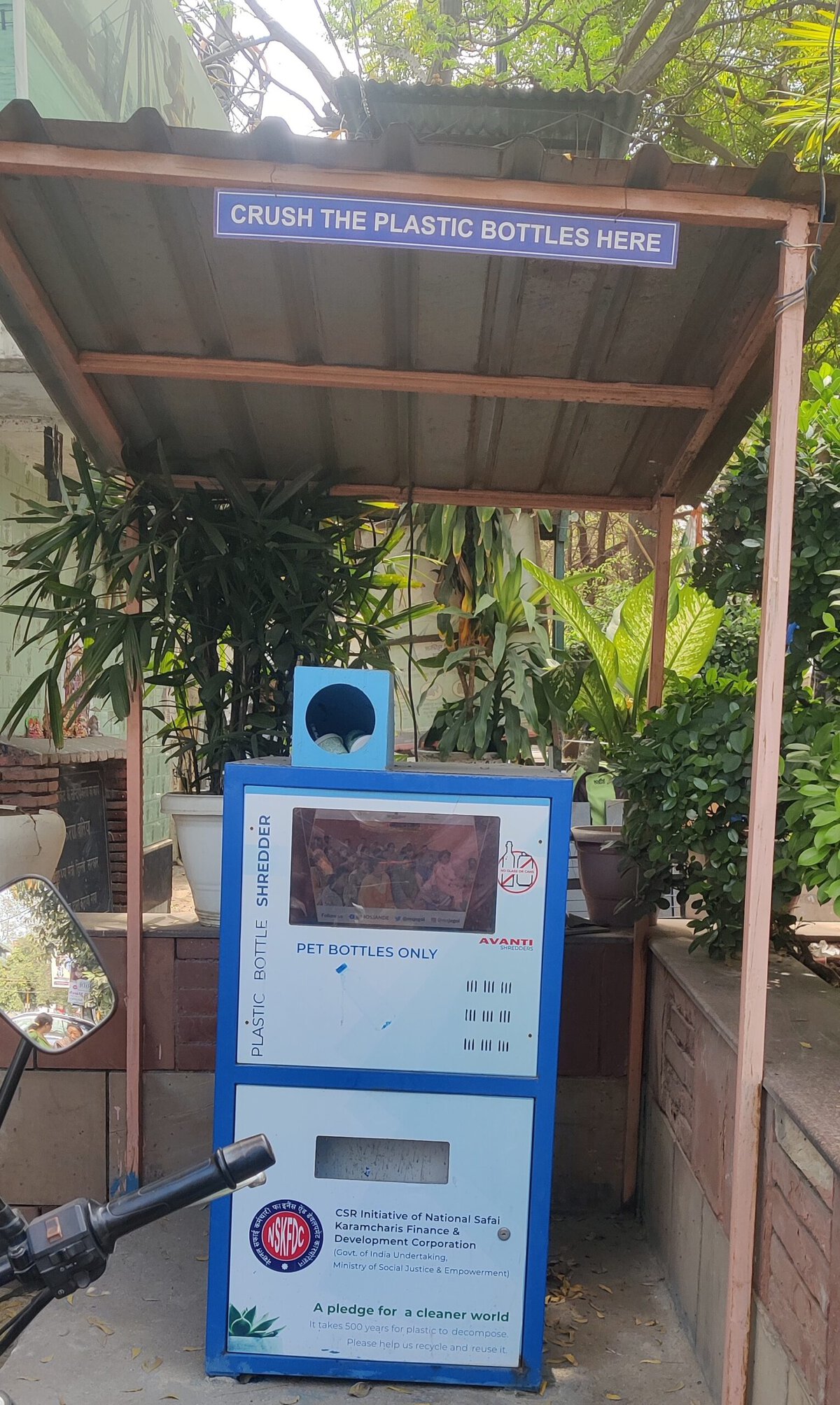 A plastic crusher machine set up outside a garbage cafe. Credit: Rishabh Jain
A plastic crusher machine set up outside a garbage cafe. Credit: Rishabh Jain
Plastic collection efforts across India reflect a growing commitment to sustainability. In Siliguri, West Bengal, alumni of a local school are offering free meals on Saturdays to individuals who contribute half a kilo of plastic waste. Similarly, in Mulugu, Telangana state, authorities provide one kilo of rice in exchange for one kilo of plastic, with local school children actively involved in plastic collection efforts. The district collector of Mulugu aims to make his district the first in India to eliminate single-use plastic. A local couple even sent out wedding invitations printed on reusable cloth grocery bags.
While celebrating the opening of a garbage cafe in South Delhi, a municipal official said, “The garbage cafe concept has been successfully implemented by local governments in Chhattisgarh and Odisha, where it aids homeless individuals by offering them complimentary meals in return for plastic waste. In Delhi, however, our approach differs in that we aim to extend this initiative to everyone. We believe that by engaging urban residents in plastic waste management efforts, we can enhance its effectiveness.”
He added that the plastic waste collected at such cafes could be used in road construction or repurposed in gardens. In Delhi, for example, a Waste-to-Wonder park showcases replicas of the seven wonders of the world, all made from discarded materials sourced from landfills.


Become a sustaining member today!
Join the Reasons to be Cheerful community by supporting our nonprofit publication and giving what you can.
Benu Malhotra, one of the trustees of Parvaah, a nonprofit organization in New Delhi advocating against plastic usage, sees the garbage cafe as a model that should be replicated nationwide. She believes that the concept is making people from all walks of life aware of the harmful effects of plastic on the environment and also guiding them on how to effectively reuse and recycle it.
She points out that garbage cafes create a kind of virtuous cycle: “This cafe addresses waste management while also providing a warm meal to those in need, thereby incentivizing them to collect more plastic.”
The post At ‘Garbage Cafes,’ You Can Trade Plastic Bottles for Free Food appeared first on Reasons to be Cheerful.
The Danish City Reimagining Reuse
Every morning, about 50 to 100 people gather in line in front of a center owned by the municipality of Aarhus, the second-largest city in Denmark. Here, they can give — and take — all sorts of materials for free. More than two metric tons of objects pass through the center per day, from sofas to dishes, lamps to wardrobes, electronic devices to tables, all of which can be brought to new homes via cargo bikes the city lends to citizens.
The project started in 2015 when Kredsløb, a company owned by the city, noticed how much the citizens of Aarhus were throwing away. To solve this problem, they created a center called Reuse, explains Peter Christensen, its coordinator: a reimagined recycling station where goods can be taken for free.
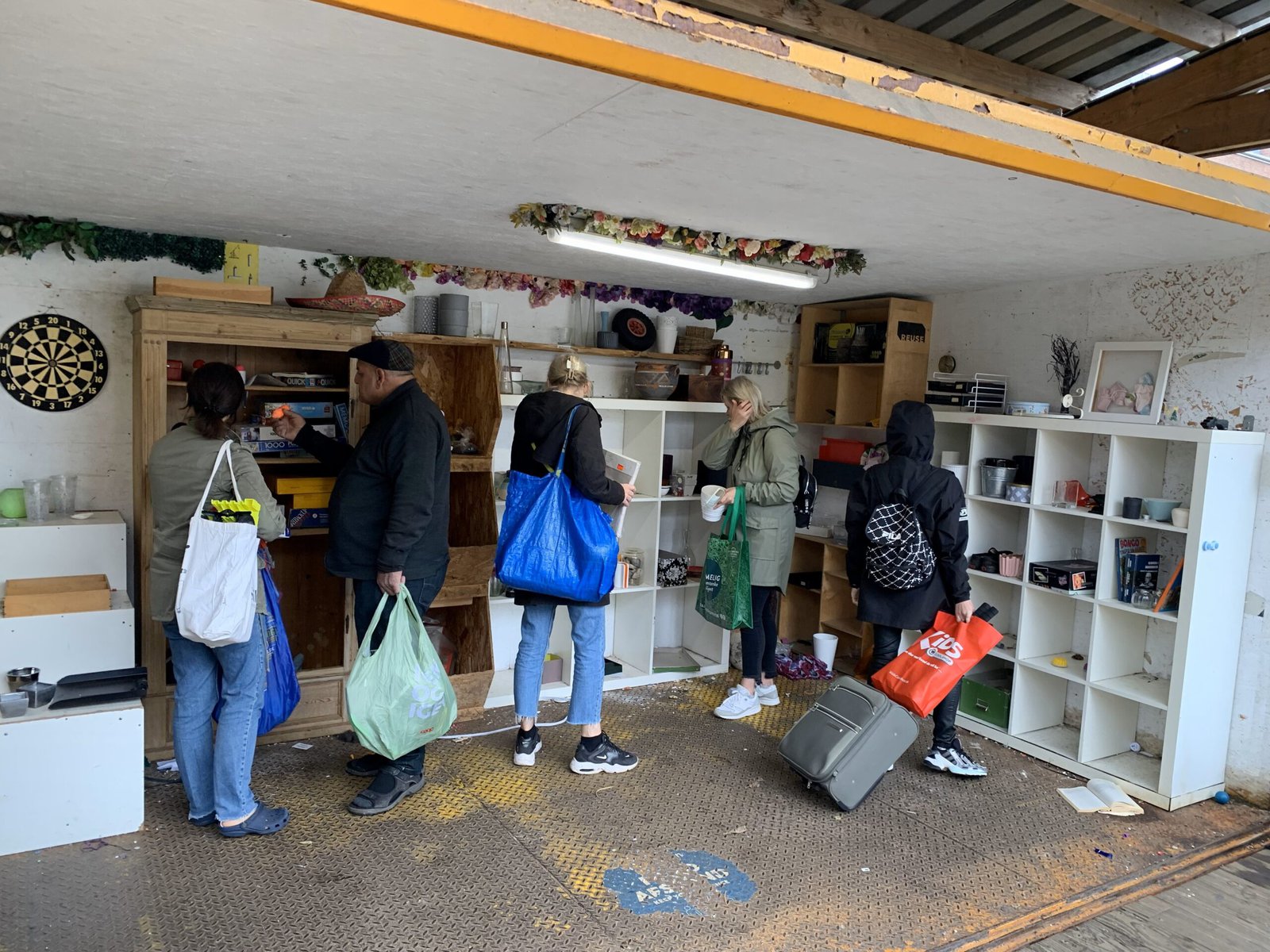 Citizens of Aarhus look for kitchenware at the circular economy center Reuse. Credit: Yael Berman
Citizens of Aarhus look for kitchenware at the circular economy center Reuse. Credit: Yael Berman
Denmark is known for its green policies and efforts to create a circular economy, in which “nothing becomes waste and the intrinsic value of products and materials are retained,” as defined by the Ellen MacArthur Foundation. It was ranked first in the 2022 Environmental Performance Index, and cities in the country are working on plans to become climate neutral. As part of one such plan, Aarhus has developed a waste strategy that will ultimately include seven material exchange centers placed inside recycling stations across the city, of which Reuse is the first.
“You take something that wasn’t worth anything and add value to it just by picking it up. This idea is maybe the key or the cornerstone of what Reuse is to me,” explains Lasse Andersen, a Reuse regular of about four years.
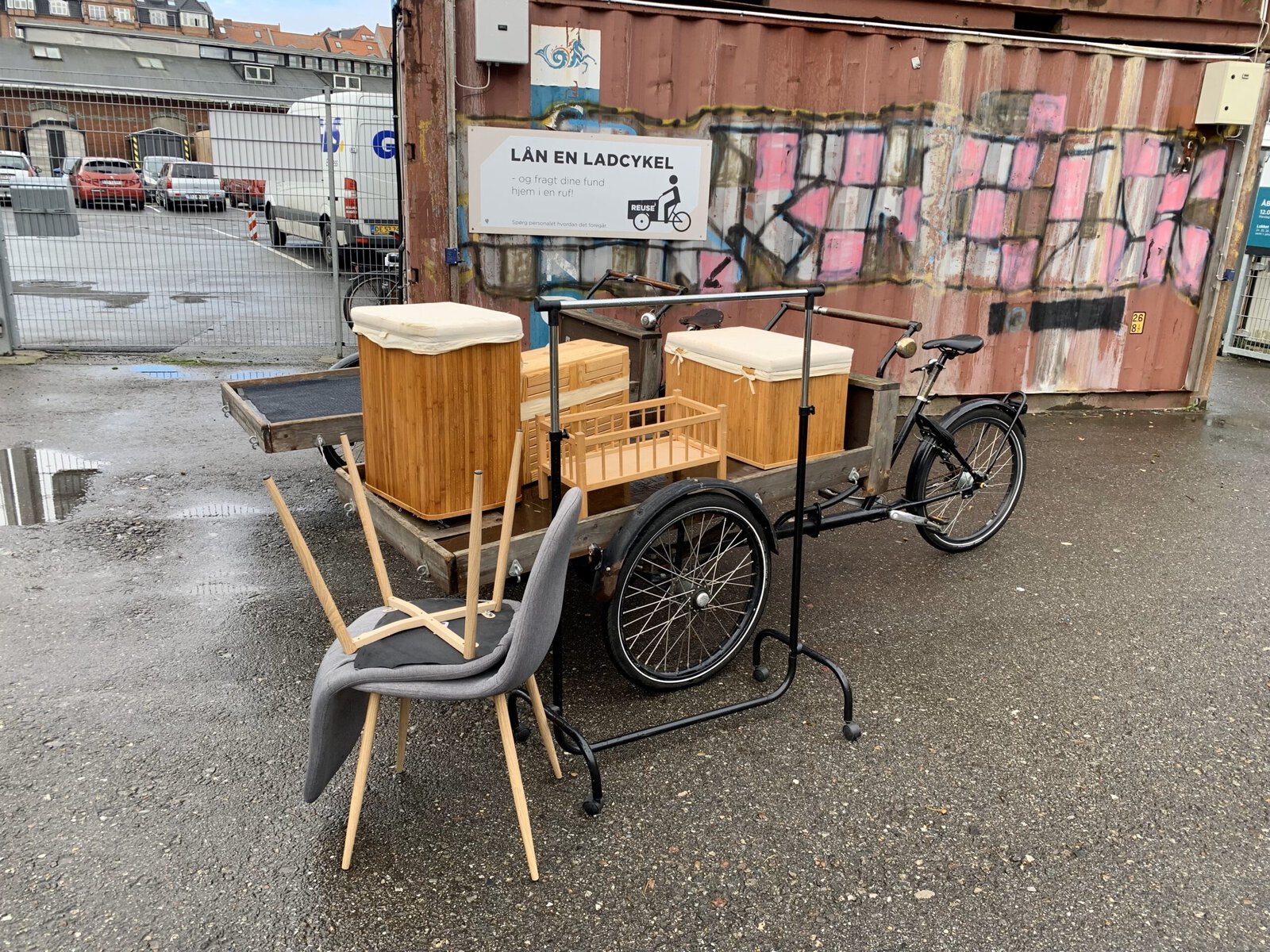 The city lends out cargo bikes that people can use to transport their goods home. Credit: Yael Berman
The city lends out cargo bikes that people can use to transport their goods home. Credit: Yael Berman
With a passion for design that led him to create a company to relaunch classic pieces from the Danish Modern movement, Andersen emphasizes the value of classic, old and possibly reused furniture. He notes that those who know what they’re looking at can find pieces from renowned, retro brands — and knowing what those items are worth makes people value them more, even if they’re used. “They just need to be seen in the right context,” he says.
Taking into account the success of the pioneer center, Aarhus is now investing in its next step: creating other centers in the city’s recycling stations so that the initiative becomes more local — and circular. Thus, the things donated by the community of a certain neighborhood will stay inside that area, explains Sofie Schousboe Laursen, who manages the project.
According to Laursen, this is why the city is actually planning to close the first center, which requires containers with goods from the surrounding recycling stations to be be transported on an approximately daily basis: “We don’t want to keep transporting, so when we open new centers in the city it becomes more circular, more local,” she says.
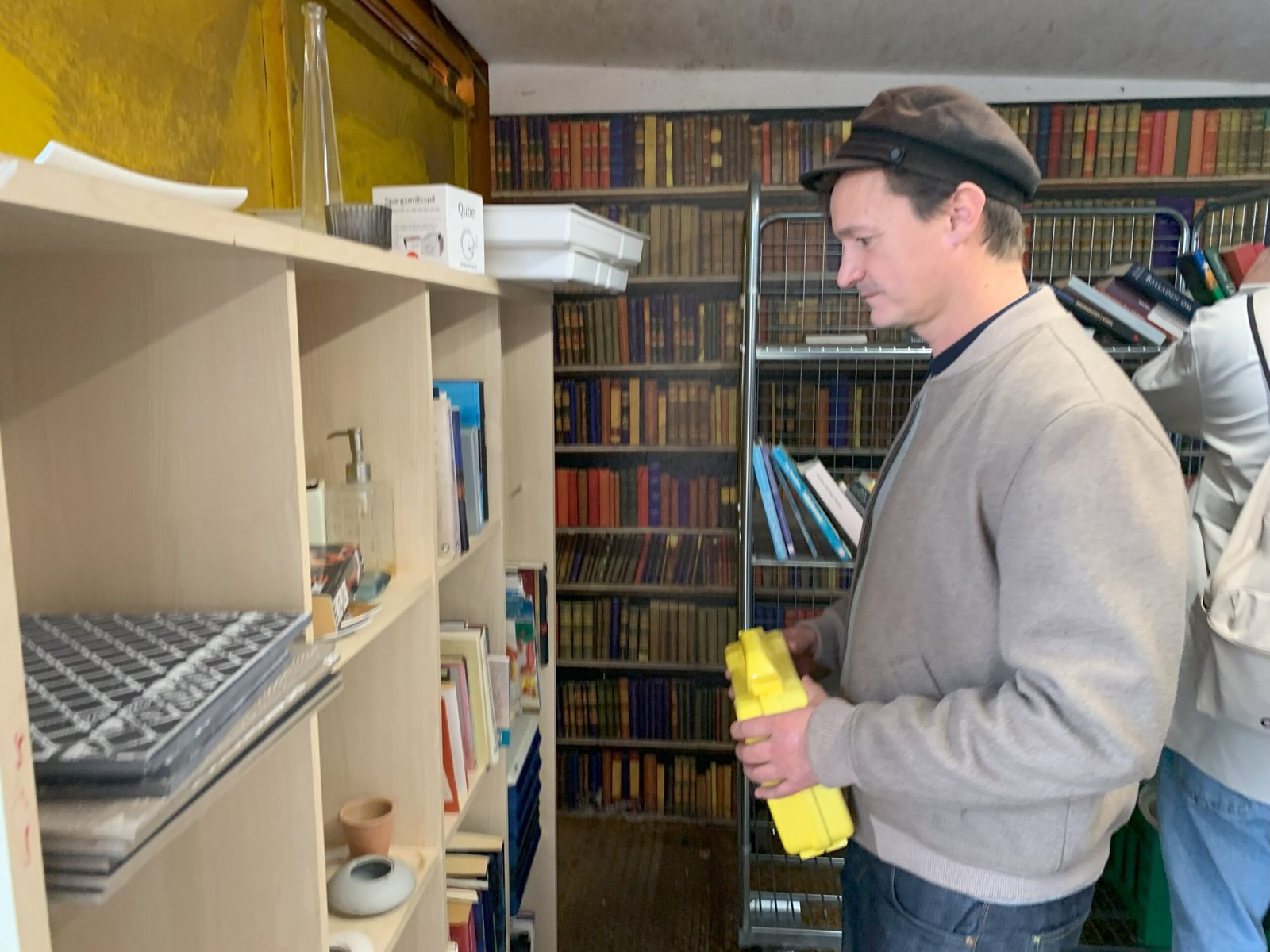 Lasse Andersen looks at donated things at one of Aarhus’ reuse centers. Credit: Yael Berman
Lasse Andersen looks at donated things at one of Aarhus’ reuse centers. Credit: Yael Berman
This is the goal of a new reuse room at the Lisbjerg recycling station, located on the outskirts of Aarhus. The area is part of one of the city’s largest urban development plans, according to the municipality, and it’s expected to grow to a population of 25,000 residents over, approximately, the next 65 years — almost 20 times the current population. That’s why it was the first recycling station to receive a reuse room. “It’s part of being prepared for the city that is being developed,” explains Laursen, adding that the recycling station itself is made with around 70 percent of recycled material.
Crushed by negative news?
Sign up for the Reasons to be Cheerful newsletter.
[contact-form-7]
The area is fairly quiet these days, but there are residents who come to drop off and take things. Among those residents are Tamer and Ulla, a couple in their 50s who go every week to look for things to reuse instead of buying them. “We don’t have a lot of money and it’s for free here. … So it’s perfect, instead of throwing it out, [there] are a lot of things that can be used again,” says Tamer.
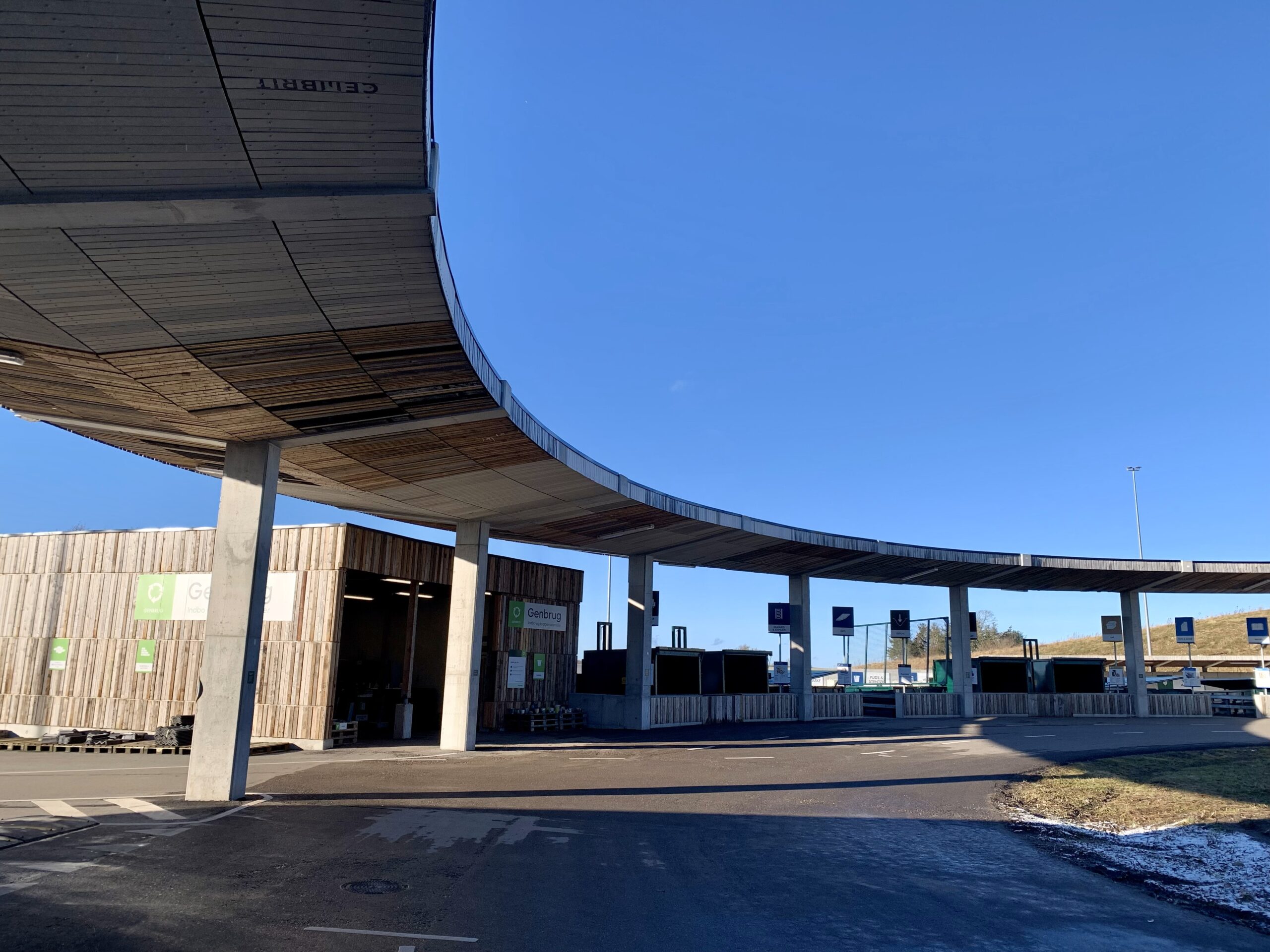 The Lisbjerg recycling station was designed to serve the influx of residents that the area is expecting in the coming decades. Credit: Yael Berman
The Lisbjerg recycling station was designed to serve the influx of residents that the area is expecting in the coming decades. Credit: Yael Berman
Ionel-Laurentiu Mavrodin, who visits the Lisbjerg recycling station about once a month, agrees. One day in early February 2024, he arrived with a friend, bringing a computer monitor and speakers. “I believe it’s good for the environment,” he says. “There’s no need to buy new stuff.”
Another center that opened after the new plan was launched was the Godsbanen center, located in the creative and cultural area with the same name. This one operates differently from the other centers, which are bigger and have staff. “It’s more cozy, self-serve. You log in with your identity number and come in,” says Laursen. “It’s a trust-based, community-based center.” It also offers a room where, with an ID, citizens can borrow things such as a sewing machine, construction tools or video games.
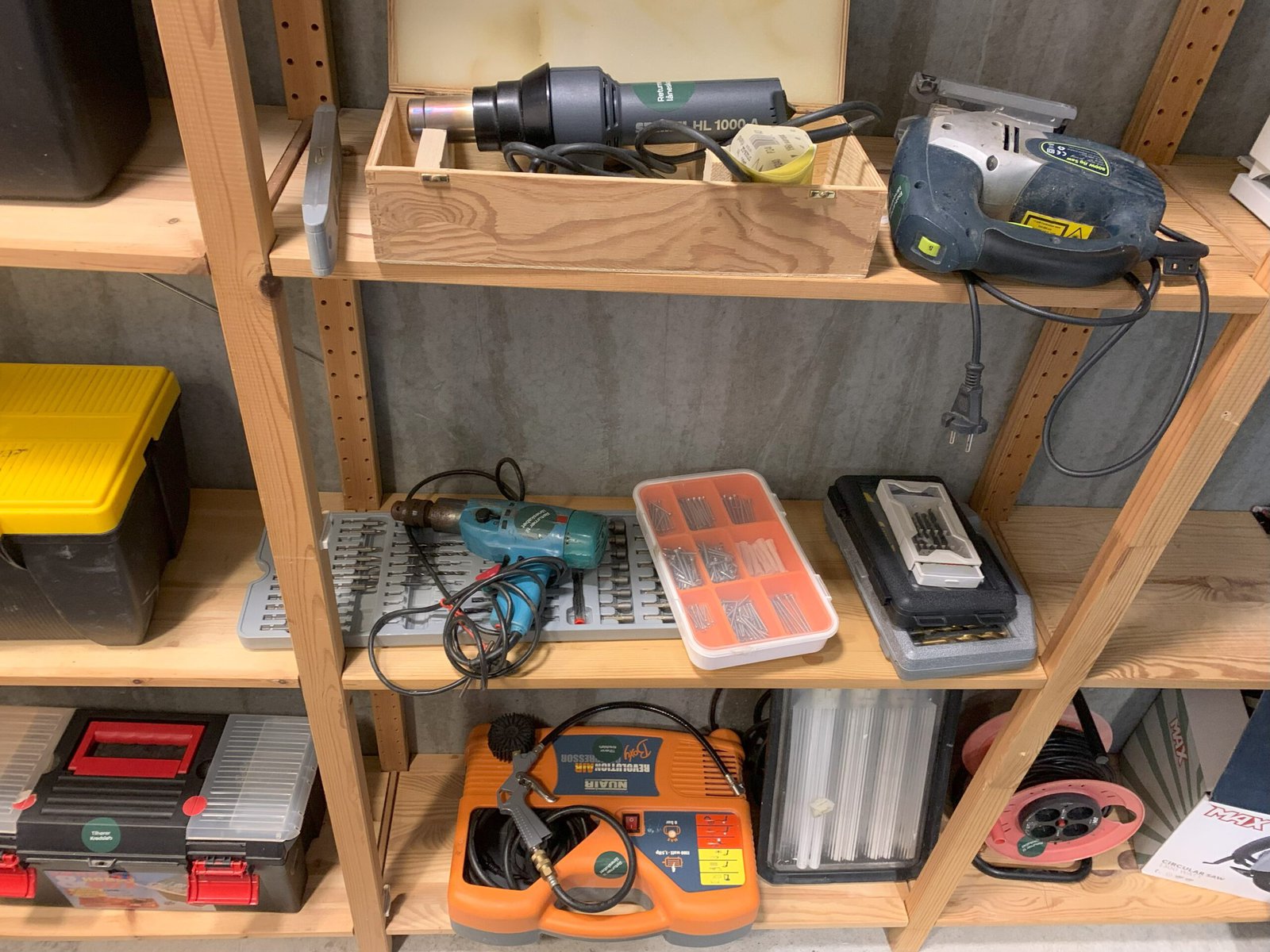 Construction tools placed at the borrowing room of the Godsbanen reuse center. Credit: Yael Berman
Construction tools placed at the borrowing room of the Godsbanen reuse center. Credit: Yael Berman
Aarhus’ plan was inspired in part by a book-saving project in Hungary, recalls Christensen, in which “Book Rescuers” circulated through the streets with special vehicles full of spare books, which they sold at very low prices. Aarhus took this concept of distributing unused things and adapted it.
Aarhus is an ideal place to experiment with such plans because its residents are keen on recycling and reusing. Besides its second-hand shop culture, the city also has a Facebook group with over 80,000 members aimed at giving things away for free.
A 2017 project, a collaboration between Aarhus University and the University of Copenhagen and led by Danish senior researcher Anders Branth Pedersen, found that most Danes were willing to spend a considerable amount of time sorting their waste.
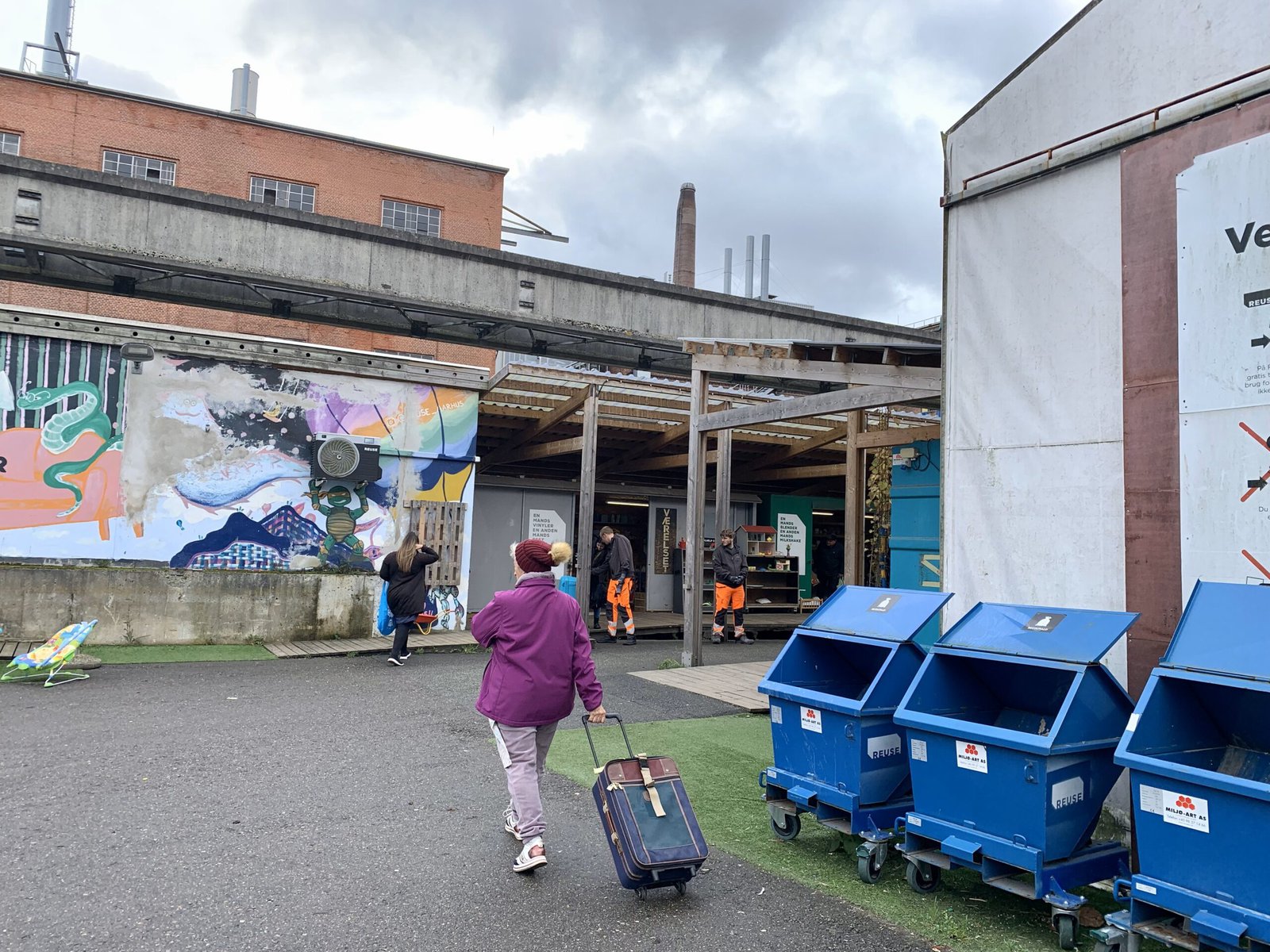 An elderly woman carries a suitcase at the circular economy center Reuse, in Aarhus, Denmark. Credit: Yael Berman
An elderly woman carries a suitcase at the circular economy center Reuse, in Aarhus, Denmark. Credit: Yael Berman
Pedersen highlights the role of residents’ trust in their government, a factor that may also influence the success of the reuse centers. The level of trust in Denmark is unusual compared to other countries, with higher trust rates for both central and local governments. When asked if they trusted that the municipality was handling the waste correctly, only 10 percent of Danes expressed low trust.
Christensen, Reuse’s coordinator, notes that people in developing countries are naturally inclined to keep things or give them another life, whereas in a wealthier country like Denmark, people sometimes give away goods that have barely been used at all. “Maybe 20, 30 percent of all the things we have here [at the center] are 100 percent unused,” he says.
Changing people’s behavior is a slow process, Christensen notes. But he is proud of what Aarhus is achieving. When it comes to building a circular economy, he notes, convincing citizens to go to recycling stations and pass on their unused objects is a crucial step.
The post The Danish City Reimagining Reuse appeared first on Reasons to be Cheerful.
Two Cheers for Circularity
by Gary Gardner

Durable materials and repurposed structures contribute to circularity. (Kevin Martin Jose, Unsplash)
Here’s some bad news for folks who see a circular economy as a way out of the polycrisis: Trends in global materials use, which recently bent modestly in the direction of circular flows, are flattening once again. The Circle Economy Foundation in Amsterdam reported in January that secondary materials amounted to only 7.2 percent of all materials in the global economy in 2023, down from 9.1 percent in 2018. (Secondary materials are recycled, reused, or repurposed materials.) Put differently, a growing share of materials used in the global economy in 2023 came fresh from mines, forests, farms, or oceans.
The authors of the Circularity Gap Report 2024 assert that “we cannot recycle our way out” of unsustainable global materials use. Instead, they say, we need circular economies, economies that rely not only on recycling, but also on reduced consumption of materials, longer-lasting products, and greater use of renewable resources. Their counsel makes good sense, as far as it goes.
But circular economies are not comprehensive enough to make economies sustainable. Helpful as they may be, circular strategies should not be mistaken for the steady state economy.
Why Materials Matter
Building circular economies is a huge challenge given the massive flows of materials that course through the world’s economic veins. In the past half century, societies worldwide have more than doubled their extraction of biomass (like forest products) and fossil fuels, and nearly quintupled the mining of non-metallic minerals. This heavy use has accelerated as economies and populations have grown, so that in just the five years between 2016 and 2021, humanity consumed 28 percent of all the materials used since 1900.
Given this acceleration, and because material flows in most economies are linear, the appetite for materials is projected to grow as economies expand. Already, the world’s economies consume 100 billion tons of materials each year. By 2050, just a quarter century away, materials extraction is projected to double relative to 2015 levels, “threatening a total breakdown of Earth’s life support systems, which are already at a breaking point,” the report says.

Increase in global extraction of materials, by group (International Resource Group).
Indeed, humanity’s intensive use of materials explains much of the environmental damage generated by economies worldwide. UNEP’s International Resource Panel reports that natural resource extraction and processing in 2017 was responsible for 90 percent of global biodiversity loss, 90 percent of water stress, and 50 percent of global greenhouse gas emissions.
Moreover, the Circularity Gap report draws a direct line between resource use and the six breached “planetary boundaries” identified by the Stockholm Resilience Centre. (Planetary boundaries define a “safe operating space for humanity” in nine natural domains. The six breached domains are climate change, biosphere integrity, land use, freshwater use, biogeochemical flows, and novel entities.) Planetary boundaries analysis gives a picture of the extent to which current consumption of materials exceeds nature’s capacity. The projected increase in materials consumption will deepen our overshoot of nature’s supply of goods and services, and possibly extend that overshoot to other domains.
The Circularity Gap identifies high-leverage economic sectors for intervention. The 2023 report found that applying 16 circular solutions across four domains—the food system, the built environment, mobility and transport, and manufactured goods and consumables—could reverse the overshoot of five planetary boundaries and limit warming to two degrees.
It also outlines different strategies by country income group. Industrial countries could focus on the built environment, emphasizing renovation and certification of materials in the secondary market, and on manufacturing and design for circularity. Middle-income nations might also prioritize manufacturing, in particular directing capital investments to promote green tech. Low-income countries would focus on the food system, ensuring that smallholder farmers have access to land and affordable credit. They would also use building codes and public procurement to promote circular building practices.
The Report’s Limits
For all its merits, the report fails to acknowledge the limits of circularity, and this omission arguably misleads readers regarding its potential.
Circular economy advocates overlook a few basic physical truths in their enthusiasm for their model. First is the reality that economic activity wears down the world it transforms. Materials and fuels dissipate with use or are lost, reducing the usable stocks of resources and ensuring that virgin materials in the future will come from less accessible sources.
Evidence of the increased difficulty in finding resources is everywhere. Oil drilling, once a matter of sticking a pipe in the ground, now requires exotic subterranean technologies like fracking or even drilling at the bottom of the ocean. Meanwhile, metal ores are typically leaner overall: The global average copper ore contained four percent copper in 1900 but only 0.62 percent in 2012. Water tables are falling in many more places than they are rising, with nearly half of the nearly 85,000 wells in the USA having declined significantly over the past 40 years. In a world of finite resources, ongoing extraction will invariably reduce available stocks.
Recycling can delay resource depletion, but recycling cannot make materials flows fully circular. Some materials are uneconomic to recycle. Others, like paper, decline in quality with each round of recycling. Still others require large amounts of energy to separate component elements. And some recycling—of plastic, for example—requires coordination across various flows for the full recycling potential to be achieved. Thus, even valuable materials like metals are recycled at only modest levels, often less than 50 percent.
In 2011, the International Resource Panel assessed global recycling rates and found that fewer than twenty elements had rates above 50 percent (blue); virtually none were above 75 percent. More than thirty elements (red) had no functional recycling at all. In sum, a majority of the elements employed in the economy were used just once, then were lost from economic stream, mostly to landfills or incinerators, or to dissipation.
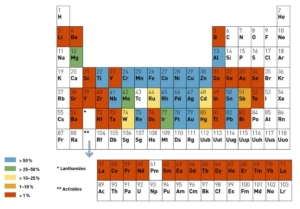
Most elements in the global economy are recycled at low rates, if at all. (International Resource Panel)
Governments worldwide have set seemingly ambitious recycling goals to increase the share of material that circulates. The USA’s National Recycling Goal is 50 percent by 2030. The EU has set recycling goals of 65 percent for municipal solid waste by 2035, 70 percent of construction waste, and 55–80 percent of electronic waste. These goals are ambitious only by the historical standards of industrial economies.
But consider that mathematically, a 75 percent recycling rate implies that after five rounds of recycling, only 24 percent of the original material remains in circulation (if the share not recycled never enters a recycling stream). At a 50 percent recycling rate—the U.S. goal for 2030—only 3 percent of the original material remains after five rounds.
While lofty recycling goals can slow the loss of materials, recycling still leaks meaningful quantities of increasingly scarce materials. It does not produce a circular economy.
Circular is Not Enough
For these reasons, Herman Daly assessed the potential of a circular economy very critically. A circular economy can approximate a steady state economy only if it “relies on natural biophysical cycles powered by the sun” and if its scale does not exceed the biosphere’s capacity for regeneration and absorption. The scale requirement is what is neglected in conventional economics—and arguably is overlooked by proponents of circular economies.
Moreover, Daly asserts that the circularists also fail to appreciate an idea familiar to Herald readers, the trophic structure of the economy. Just as primary producers are the base of production in the pyramidal economy of nature, providing nutrients and energy for consumers at trophic levels above, so do agriculture and extraction serve as the base of the human economy, feeding higher levels of economic activity including manufacturing and services. Indeed, Brian Czech, originator of the trophic theory, has written of the “triangular economy” (invoking the shape of trophic level diagrams) as a counterpoint to circular economy enthusiasts.
One implication of the trophic theory is that manufacturing and services atop the pyramid cannot grow any faster than the agriculture and extractive sectors at the base—and clear limits apply to these. I don’t know of any circular economy advocates who include these limitations in their analysis.

Phenomena that seem to defy physics are usually an illusion. (Deviantart, CC BY 3.0 DEED)
So Daly sets a pretty strict standard for a circular economy. For him, a circular economy bounded by nature would surely look more like the Flintstones than the Jetsons. (Outside the cartoon realm, I wonder if a truly sustainable circular economy would be akin, in principle if not in all its detail, to life in “A Swiss Family Robinson.” In that 1960 film, human cleverness transforms natural materials into goods that meet daily needs, without stressing nature.)
In Daly’s acceptable circular economy, the focus of human advancement would likely shift from the material to the cultural, with material inputs playing an essential, but circumscribed, supporting role. Global Circularity 2024 points to progress in this direction in Angola, Eswatini, Togo, Nepal, the Gambia, countries that made real progress in life expectancy, nutrition, and energy access without increasing their materials use, and in some cases, while decreasing it.
In a similar spirit, other countries are pursuing a “wellbeing economy” strategy that focuses more on quality of life than on material accumuliation. The Wellbeing Economy Governments partnership (WEGo), which includes New Zealand, Scotland, Iceland, Wales, and Finland, are leaders in this regard, using a range of indicators for wellbeing to guide government decision-making, for example.
In sum, a circular economy can help the world’s economies use resources more judiciously. But it would not guarantee that materials use is capped, nor that materials extraction and use would remain within boundaries set by nature. Only degrowth toward a steady state economy—likely assisted by circular economy principles—can create such a truly sustainable civilization.
Gary Gardner is CASSE’s Managing Editor.

The post Two Cheers for Circularity appeared first on Center for the Advancement of the Steady State Economy.
Shopping ‘Wonky’ Keeps Imperfect Goods From Going to Waste
Buying non-perishable products like tea, cookies, chocolate and soap from UK online retailer Love Health, Hate Waste has not only saved eco-conscious shopper Sylvia Tillman nearly $320 over the past year, but buying products that would otherwise go to landfill also puts her mind at ease.
Love Health, Hate Waste sells products that are past their “best before” date, but not deemed to be expired and so still safe to consume, at up to 90 percent off the original retail price. Some of the packaging is slightly damaged too, but the products are unopened.
None of this bothers Tillman, who is based in Ramsgate, UK. In her work as a tension release exercise coach, she is always on the lookout for health food bargains, which Love Health, Hate Waste specializes in. The only downside, she says, is that its stock changes regularly, so shopping on the site can take some time. But Tillman actually appreciates this for the novelty it brings.
 “I’m generally eco-conscious, and don’t waste resources anyway,” says Tillman. Courtesy of Sylvia Tillman
“I’m generally eco-conscious, and don’t waste resources anyway,” says Tillman. Courtesy of Sylvia Tillman
“As I love exploring new products that I’d never tried before, I love this aspect alongside the potential savings in money or of food to landfill,” says Tillman.
Buying flawed packaged products seems like a natural extension of the imperfect fruit and vegetable movement, which UK shoppers have embraced since supermarkets like Sainsbury’s and ASDA launched related promotions — the latter collaborating with celebrity chef Jamie Oliver in 2015. The term “wonky” has since become synonymous with products that have aesthetic flaws, but are otherwise fit for consumption.
Wonky fruit and vegetables have become a no-brainer in the UK as a way for farmers and retailers to cut down on food waste. Meanwhile, shoppers save money buying less-than-perfect produce that, a decade ago, would not have ended up on shelves at all.
Seventy-seven percent of UK adults YouGov surveyed last November said they’d be likely to purchase wonky produce next time they went shopping, with 72 percent driven by lower prices. Sixty-three percent are motivated to reduce food waste, with conservation group WWF finding that around 2.9 million metric tons of edible food is wasted on UK farms each year.
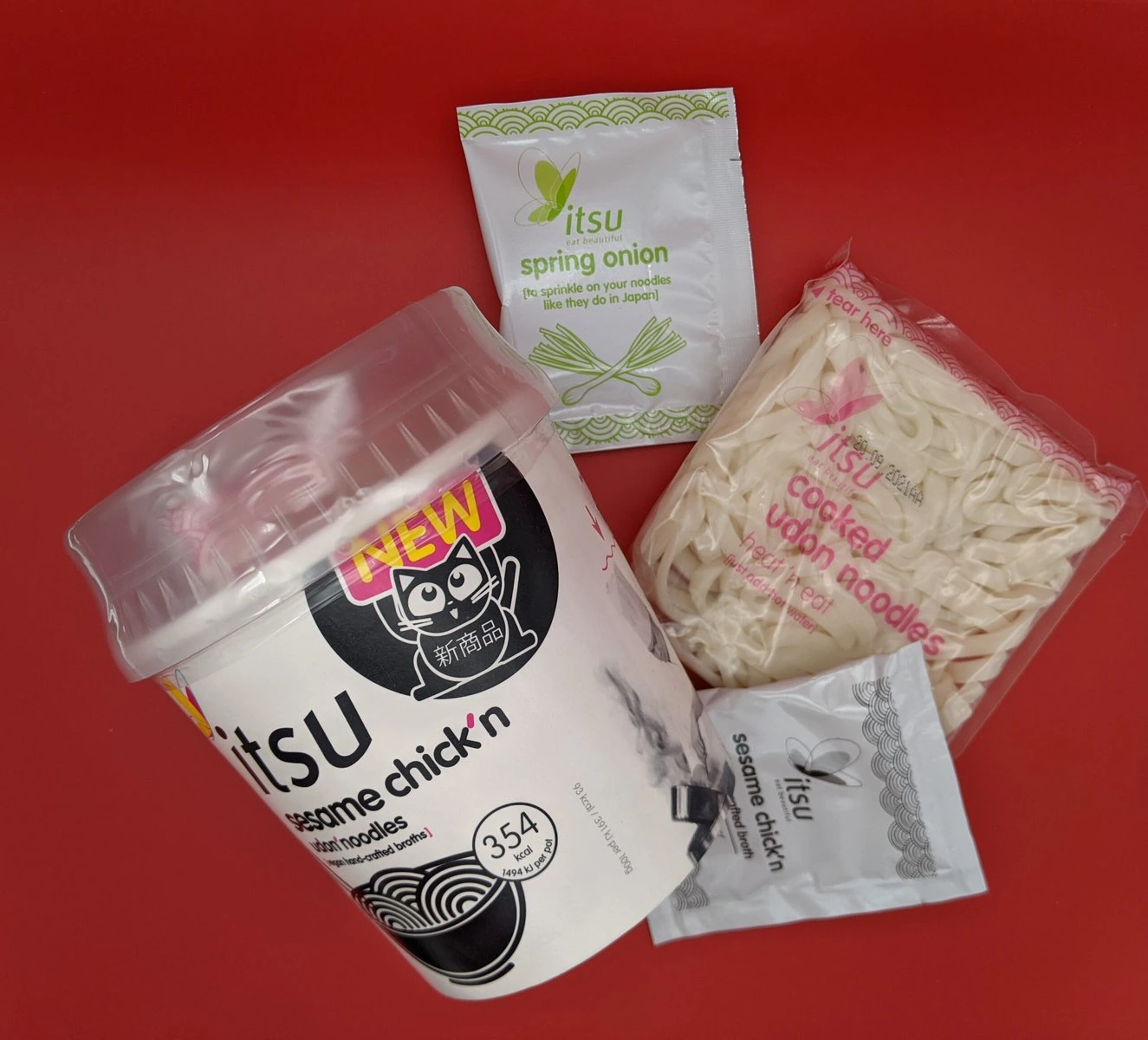 Often, what makes goods wonky is barely noticeable, like the slightly damaged lid of this instant noodle container. Courtesy of Love Health, Hate Waste
Often, what makes goods wonky is barely noticeable, like the slightly damaged lid of this instant noodle container. Courtesy of Love Health, Hate Waste
The trend is now extending beyond fresh produce, giving a new life to goods whose packaging has been bumped and bruised, leaving the inside item unharmed. For example, selling excess, obsolete and imperfect beauty products at half price or more, Boop launched its online marketplace in November 2023. Wonky Coffee, previously known as Odd Coffee, sources its flawed pods from a number of big brands and is said to have rescued around one million of these from landfill in 2021, its first year of business. It plans to reach 50 million by 2025. Earth and Wheat rescues wonky bread from its partner bakeries. And Amazon even opened a pop-up seconds store in London last year, selling returned goods at up to half price.
In the US, meanwhile, salvage stores, which stock damaged, discontinued, surplus and close-to-expiration-date items, are more popular than ever as grocery bills continue to rise, the New York Times reports, while rescuing $161 billion of food going into landfill each year. Shoppers are also finding deals on returned and surplus products on sites like Liquidation.com and Bulq, with some offering auctions on entire pallets.
What wonky means for retailers
Hema Stewart, founder of London-based recyclable wrapping paper brand Curlicue, introduced wonky gift wrap kits to Curlicue in 2019 as an avenue for selling wrapping paper that became slightly damaged after being transported for sale to market stalls. Sold at a 60 percent discount, the wonky kits include paper, tags and twine that have slight damage or are simply shorter than the ideal retail length. The kits now make up around 10 percent of Curlicue’s sales.
 Curlicue’s wonky wrapping paper, tags and twine are very slightly damaged or just not the ideal retail length. Courtesy of Curlicue
Curlicue’s wonky wrapping paper, tags and twine are very slightly damaged or just not the ideal retail length. Courtesy of Curlicue
“We had been looking at the wonky fruit and veg campaigns that had been going on, and now the ‘wonky’ phrase has really caught on in society. Our wonky kits became an easy way for me to make sure there wasn’t product wastage, and that we were offering something at a slightly lower price point for people,” Stewart explains.
Stewart has observed how the popularity of secondhand platforms like Vinted has normalized giving overlooked items a new lease on life, with shoppers incentivized by sizable discounts, as mainstream prices continue to rise.
“That shift has had an important effect on how people are buying, and a lot are going back to a more traditional mentality of how you reuse things, and make them last longer,” she says.
Crushed by negative news?
Sign up for the Reasons to be Cheerful newsletter.
[contact-form-7]
Likewise, rather than disposing of cosmetically damaged returns, bubble kit maker Dr Zigs offers a wonky range at half the usual price, also making up around 10 percent of its sales. And like Stewart, owner Paola Dyboski has noticed a change in shopper mindsets.
“People are wising up to the way brands have put a veil over our eyes to make us believe we have to have something that’s perfect. Now people think more about reusing and upcycling,” Wales-based Dyboski says.
The best part, she adds, is being able to help budget-impacted customers.
 Half-price wonky bubble kits make up about 10 percent of Dr Zigs’ sales. Courtesy of Dr Zigs
Half-price wonky bubble kits make up about 10 percent of Dr Zigs’ sales. Courtesy of Dr Zigs
“I’ve had so many messages, especially around Christmas, from customers saying they had always wanted to buy our bubbles but couldn’t afford it, and this has made it possible. That kind of feedback makes it worthwhile,” she says.
Helping people embrace the “perfectly imperfect”
Sustainable shopping expert Jennifer von Walderdorff confirms that the wonky shopping movement is helping people embrace the “perfectly imperfect” and move away from the social media-fueled desire to buy things to achieve a certain influencer approved look and lifestyle.
“Buying into this movement is not only smart but sustainable,” von Walderdorff says.
She notes, however, that culturally, there is still an element of wanting to hide that imperfection, meaning wonky products may reach a limited audience.
“Serving a meal with chopped-up wonky vegetables is one thing, as they can be concealed, as can the packaging you purchase your makeup in. But wearing a garment with an uneven hem, or having homeware that has decipherable imperfections is where the adoption may be harder,” she says. “If ‘wonky’ retail can be concealed, it will be the bargain of the century, but trying to sell this en masse may be tough.”
For that reason, Yasmine Amr, founder of beauty brand Boop, is focused on educating consumers about what it means to buy wonky. For example, two-thirds of the 300 UK women the company surveyed last year weren’t aware that it’s common practice in the beauty industry to destroy excess stock, products with damaged external packaging and unopened returns.
“A key challenge will always be consumer trust. Shoppers want to be sure they’re getting the real deal and their products will deliver results, even if the external box is missing or there’s been a misprint on the label,” says Amr.


Become a sustaining member today!
Join the Reasons to be Cheerful community by supporting our nonprofit publication and giving what you can.
To tackle this, Boop only sources directly from brands to make sure all products are safe, haven’t been tampered with, and are within their best-before dates. The company layers its own quality control checks over this, too.
“We’re focused on educating customers about product waste and how using platforms like Boop can help them lead more sustainable lives without sacrificing quality and luxury. For instance, changing a shampoo’s name due to a brand marketing decision shouldn’t be a reason to destroy thousands of units if the actual product is identical,” says Amr. “If consumers are aware of that, they’ll see there’s nothing truly wonky about these products.”
For Silvia Tillman, it’s about a wider approach to not wasting resources throughout her everyday life and tasks. “I’m generally eco-conscious, and don’t waste resources anyway. I’m impressed by and always keen to learn more of old-fashioned household hacks, like cleaning with vinegar or bicarbonate of soda, and doing laundry with soap nuts or ivy leaves,” she says.
The post Shopping ‘Wonky’ Keeps Imperfect Goods From Going to Waste appeared first on Reasons to be Cheerful.
The 3D-Printed Affordable Housing of the Future Will Be Recyclable
When you imagine a 3D-printed home, you probably picture a boxy concrete structure. As 3D printing’s popularity has grown in the construction industry — thanks to its efficiency when it comes to time, energy and cost — carbon-intensive concrete has become the go-to building material.
But a project in Maine has set its sights on something different: a neighborhood of 600-square-foot, 3D-printed, bio-based houses crafted from materials like wood fibers and bioresins. The aim: a complex of 100-percent recyclable buildings that will provide homes to those experiencing houselessness.
In late 2022, an initiative between the University of Maine and local nonprofit Penquis unveiled its prototype — BioHome3D, the first 100-percent recyclable house. Now, the pioneering project is working toward completing its first livable housing complex. It will be fully bio-based, meaning all materials will be derived from living organisms such as plants and other renewable agricultural, marine and forestry materials.
 Once the pilot project is completed and the team reaches full commercial capacity, the team will be able to print a home in as little as two days. Courtesy of the University of Maine ASCC
Once the pilot project is completed and the team reaches full commercial capacity, the team will be able to print a home in as little as two days. Courtesy of the University of Maine ASCC
As the materials are all 100-percent recyclable, so become the buildings. The materials are also all renewable. And thanks to its natural composition, the home acts as a carbon sink, sequestering 46 tons of carbon dioxide per 600-square-foot unit.
The materials for this project will mainly come from wood left over by local mills. “The wood fiber material that’s used in the mix is essentially waste wood here in Maine,” says Jason Bird, director of housing development for Penquis. Bird is referring to what’s known as wood residuals: materials that, he explains, “pulp mills or other sawmills either landfill, discard or set off to the side and rot.”
Courtesy of University of Maine ASCC
Houses like BioHome3D could be built anywhere in the world that bio-based materials are available.
According to the University of Maine, the state’s sawmills produce nearly one million tons of wood residuals every year. Since each 600-square-foot unit requires approximately 10 tons of wood residuals, 100,000 housing units could theoretically be produced every year using just sawmill residuals.
Crushed by negative news?
Sign up for the Reasons to be Cheerful newsletter.
[contact-form-7]
The University of Maine’s Advanced Structures and Composites Center received $3.3 million in funding for this project last year, and its collaboration with Penquis has set out to build a ready-to-live neighborhood with nine 3D-printed homes for people experiencing houselessness. As the team undergoes the final regulatory hurdles, Bird anticipates that houses could be ready to live in as early as this spring.
 “The wood fiber material that’s used in the mix is essentially waste wood here in Maine,” says Jason Bird. Courtesy of the University of Maine ASCC
“The wood fiber material that’s used in the mix is essentially waste wood here in Maine,” says Jason Bird. Courtesy of the University of Maine ASCC
Once this pilot project is completed and the team at the University of Maine reaches full commercial capacity, Bird says the team will be able to print a home in as little as two days.
“That would include the shell of the house — the roof, walls, floors system,” Bird explains. “Long-term [infrastructure projects] could include cabinets, countertops, bath fixtures. And what gets me so excited about this project is that the technology isn’t just solving a local problem, it could be replicated around the world.”
Dr. Habib Dagher, executive director of the Advanced Structures and Composites Center, confirms that the technology is intended to be widely replicated.
“The goal of this research is to create a system for constructing homes that alleviates strains on the supply chain and addresses labor shortages, while providing economical and sustainable housing,” says Dr. Dagher. “This technology can be used anywhere in the world that has access to bio-based raw materials. We are focused on scaling up production technology to drive down costs and increase availability.”
And after enduring a year of extreme weather in Maine, with sensors reporting temperatures ranging from 1 degree to 105 degrees Fahrenheit, BioHome3D met all sustainability, strength, and durability requirements for US building codes, as well as the design requirements of the International Code Council code.
“Doing this project in a place like Maine, which has some of the most extreme temperatures in the continental US, is vital because it can prove that this material can endure huge temperature swings,” says Sarah Goehrke, founder of Additive Integrity, a consulting service that focuses on the examination and sustainable acceleration of industrial 3D printing. “The fact that BioHome3D survived for a year is very important proof going forward.”
Courtesy of the University of Maine ASCC
The BioHome3D prototype was printed on the world's largest 3D polymer printer at the University of Maine's Advanced Structures and Composites Center.
Initial printing speeds of 20 pounds per hour have since ramped up to nearly 500 pounds per hour, significantly reducing construction costs. This efficiency, combined with local materials, makes the process more sustainable and resilient to global supply chain disruptions.
The project is a timely response to an already pressing and worsening global housing crisis. UN-Habitat predicts that by 2030, three billion people will require improved housing. And with traditional construction contributing a staggering 27 percent of global greenhouse emissions, less-polluting alternatives will need to rise to the occasion. In Maine, the need is clear: the state is already experiencing a shortage of 20,000 affordable housing units.
“What’s more innovative about this project [than other 3D housing initiatives] is both that it’s bio-based, and that it’s geared fully toward addressing the housing crisis,” says Goerhke.


Become a sustaining member today!
Join the Reasons to be Cheerful community by supporting our nonprofit publication and giving what you can.
3D-printed houses produce significantly less waste than conventional construction, as builders are able to print exactly the amount of material they need for a given project, and minimal space is needed for storage materials. And with the ability to store all materials in the same space, the energy otherwise required to transport materials between sites is eradicated.
One forecast projects that the global 3D construction market will soar by 91 percent from 2021 to 2028.
“Building many smaller structures in a short amount of time is what the housing crisis needs to address unhoused people and help to create larger communities quite quickly,” says Goerhke.
The post The 3D-Printed Affordable Housing of the Future Will Be Recyclable appeared first on Reasons to be Cheerful.
A Tradition That Keeps Christmas Trees Alive
When Emma Klein went to pick up her family’s Christmas tree one morning in early December, she wasn’t getting just any tree. She was picking up the same Norway spruce her family celebrated with last year, and every year since 2018.
That’s because Mr. Sparkles — a moniker bestowed on the tree by Klein’s three-year-old daughter — is alive. The evergreen is growing in a pot, and is one of about 1,000 living trees London Christmas Tree Rental has available to rent each holiday season.
Klein’s family started renting from the company when she was looking for an eco-friendly alternative to the traditional options of an artificial or a real, cut tree. Each year, up to eight million cut holiday trees are sold in the United Kingdom and between 25 and 30 million are sold in the United States, most of which are discarded by early January. London Christmas Tree Rental and other similar initiatives offer a twist on the annual holiday tradition by providing living trees. These pot-grown evergreens can be used for multiple holiday seasons, and even go on to be planted in the ground after they outgrow their celebratory years.
 Klein and her daughter with Mr. Sparkles in 2019. Courtesy of Emma Klein
Klein and her daughter with Mr. Sparkles in 2019. Courtesy of Emma Klein
“Why cut down the tree in the first place and recycle it when actually you could just reuse it?” says Jonathan Mearns, co-founder and director of London Christmas Tree Rental.
For environmentally-minded consumers, choosing the greenest holiday centerpiece option can be confusing. Artificial trees have the benefit of being reusable. However, they typically are made of plastic and steel — two materials that are carbon-intensive to produce. Most artificial trees are made in China, so they rack up more of a footprint because of shipping. An artificial tree would need to be used for between seven and 20 years to match the impact of annual cut trees, according to the Carbon Trust. And artificial trees are often not recyclable.
Real trees, in contrast, sequester carbon as they grow. After a tree is cut, it’s usually replaced with new saplings, which will continue to capture carbon. Tree farms also offer other environmental benefits, like habitat for birds and pollinators. But the plantations are generally limited to only a couple of tree species, and some use pesticides that can be damaging to biodiversity.
“It’s a farm,” says Paul Caplat, an ecologist at Queen’s University Belfast. “It’s not a forest.”
The biggest factor determining a real tree’s carbon footprint is what happens to it after the holidays, according to Caplat. If a tree ends up decomposing in a landfill, it releases methane, a greenhouse gas up to 80 times more potent than carbon dioxide. The Carbon Trust estimates that a real tree’s carbon footprint is as much as 80 percent lower if it is instead chipped and used as mulch. Many municipalities, organizations and businesses offer recycling programs, and trees can be used to restore habitat or feed goats.
Still, as Mearns observed piles of spent trunks on the sidewalk in London early one January, he thought that there must be another option. That inspired him and his business partner to launch London Christmas Tree Rental. They started in 2018, offering 30 live trees. Over the years, they’ve ironed out kinks — like determining Norway spruces to be the most pot-friendly varietal — and grown to have about 1,000 trees.
 Trees at London Christmas Tree Rental’s pick-up site in Dulwich. Credit: London Christmas Tree Rental
Trees at London Christmas Tree Rental’s pick-up site in Dulwich. Credit: London Christmas Tree Rental
When a real tree is cut down, Mearns notes, that’s the end of its life. But the living trees can be available for up to eight holiday seasons.
Each year in early December, Mearns and his team set up four pick-up points around London, arranging the living spruces in mini forests. Children of repeat customers, like Klein, search the dense rows for their familiar tree. Over the three-and-a-half weeks the trees spend in homes, renters are responsible for keeping them watered. Then they drop them back off at collection points in early January.
Crushed by negative news?
Sign up for the Reasons to be Cheerful newsletter.
[contact-form-7]
For the other 11 months of the year, the trees live on farms in the Cotswolds, hooked up to irrigation systems. The trees are only repotted once, when they grow from three feet to four feet, to make room for their roots. Most trees are retired around the time they reach seven feet tall, according to Mearns, and they are planted on the farm.
Local variations on rental options are available in many regions. In Edmonton, capital of Alberta, Canada, a farm rents out living spruces and scotch pines. At one California tree rental company, customers can opt for “Charlie Brown” options that have a bit more character. A San Jose urban forestry organization rents out saplings at the holidays, then plants them in the surrounding area.
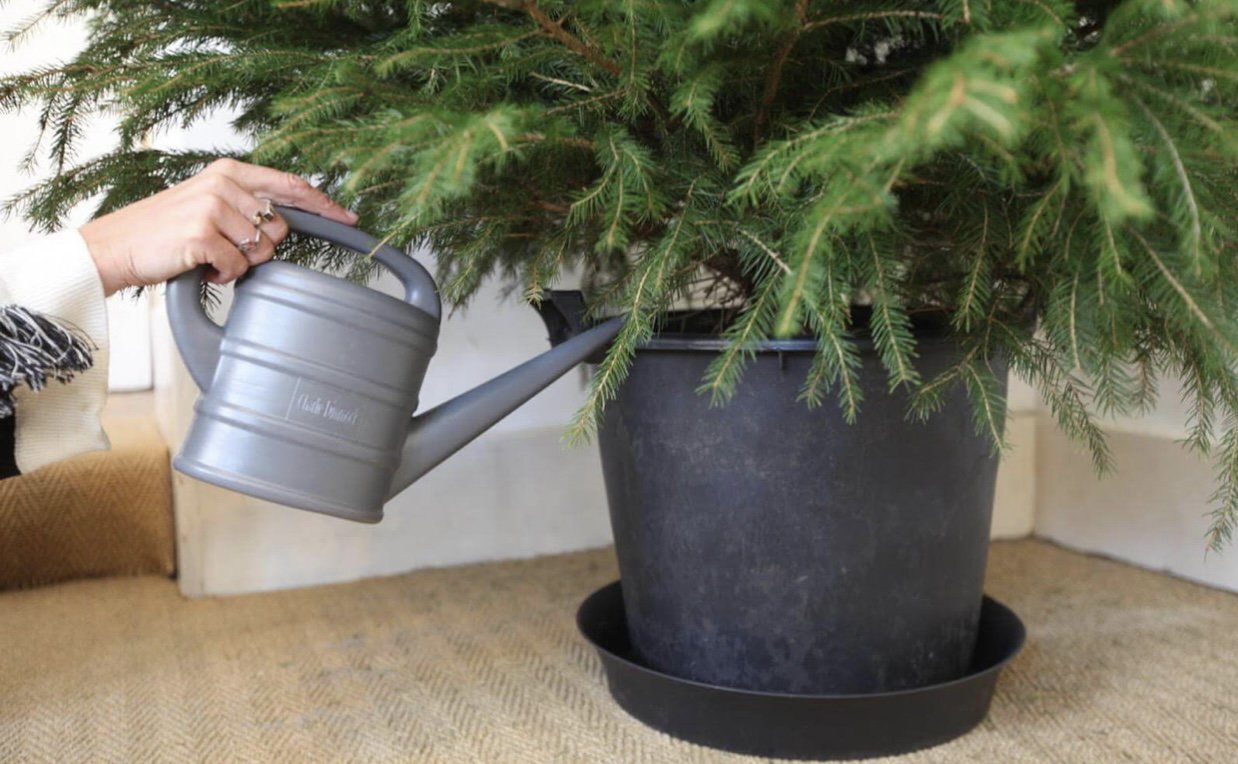 Trees in pots need watering and care to stay healthy. Courtesy of London Christmas Tree Rental
Trees in pots need watering and care to stay healthy. Courtesy of London Christmas Tree Rental
Andy Finton, a forest ecologist at The Nature Conservancy, sees benefits to renting a living holiday tree, or buying one and keeping it in a pot on a terrace or yard.
“In the scheme of ‘reduce, reuse, recycle,’ you’re literally reusing, which is pretty impressive,” he says.
A living Christmas tree, like any tree, is sequestering carbon. But Finton notes that there are practical challenges to renting live trees. A seven-foot-tall evergreen with roots and soil is heavy to move around. Trees in pots also need watering and care to stay healthy. While living trees may be a good fit for some people, he expects that they will remain a niche in the holiday tree market.
 Mr. Sparkles at the Kleins’ home in 2022. Courtesy of Emma Klein
Mr. Sparkles at the Kleins’ home in 2022. Courtesy of Emma Klein
In the scheme of greenhouse gas emissions, holiday trees are a “drop in the ocean,” notes Caplat. But every effort helps. And he sees promise in repurposing living holiday trees by planting them in appropriate places.
“Saving on the carbon emissions and possibly helping to capture more by increasing tree cover, that’s something that we all strive to do,” Caplat says. “Doing it while people have Christmas trees at home is a great idea.”
For Klein, watching the same tree grow along with her daughter has been a special experience. Her daughter, now eight, looks forward to welcoming Mr. Sparkles to their home every year.
“It’s a really great thing to know that your traditions are helping the world, even if it’s in a really small way,” Klein says.
The post A Tradition That Keeps Christmas Trees Alive appeared first on Reasons to be Cheerful.